Human Biology - Year 9 🦠🪴💉
1/70
Earn XP
Description and Tags
Jewel, use this to ace your test. You've got this! 😘😆
Name | Mastery | Learn | Test | Matching | Spaced |
|---|
No study sessions yet.
71 Terms
What is a stimulus?
Any information that your body receives that might cause it to respond.
The easiest stimuli to identify are those that we respond to physically.
What are receptors?
Structures that receive stimuli and help send it to the brain.
What are the 5 sense organs?
The eyes, ears, tongue, nose and skin.
They are external senses because they tell us about the world outside our body.
They are highly specialised to receive stimuli from the environment.
All about sight (PPIOCL)
-The pupil changes size to control how much light enters the eye
-The photoreceptor cells at the back of the eye transform the light into nerve signals for the brain. It is not your eyes that allow you to see, but your brain!
The information from you eyes is transferred to your brain, which then tells you what you are seeing.
Iris - the muslce that controls the pupil,
Optic Nerve - the nerve that carries the signal to your brain.
Cornea- part of the eye that bends the light for optimal vision
lens - focuses incoming light
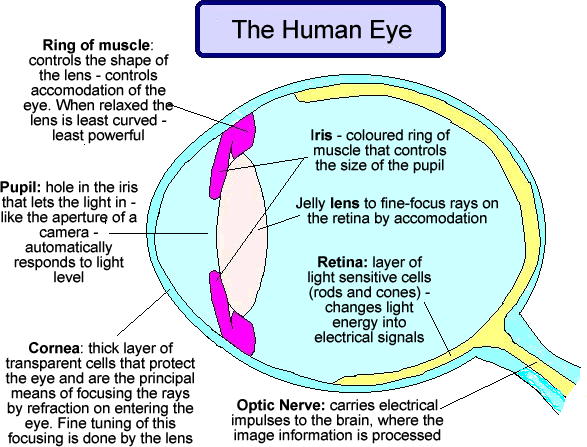
All about Hearing:
Remember the nerve!
The strumming of a guitar causes the particles in the air to vibrate. This in turn causes your eardrum to vibrate as it enters the ear canal. These vibrations are turned into nerve impulses in the middle ear which are sent to your brain through the auditory nerve which then interpret what you are hearing.
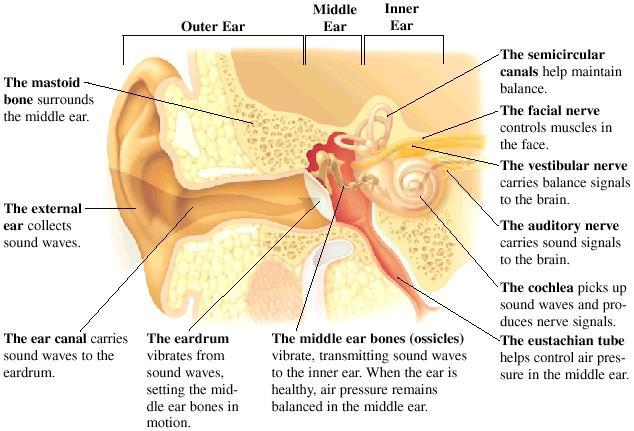
What is the cochlea?
A part in the inner ear that contains fluid that moves due to vibrations coming from the middle ear. This motion becomes an electrical signal that is passed to nerve cells.
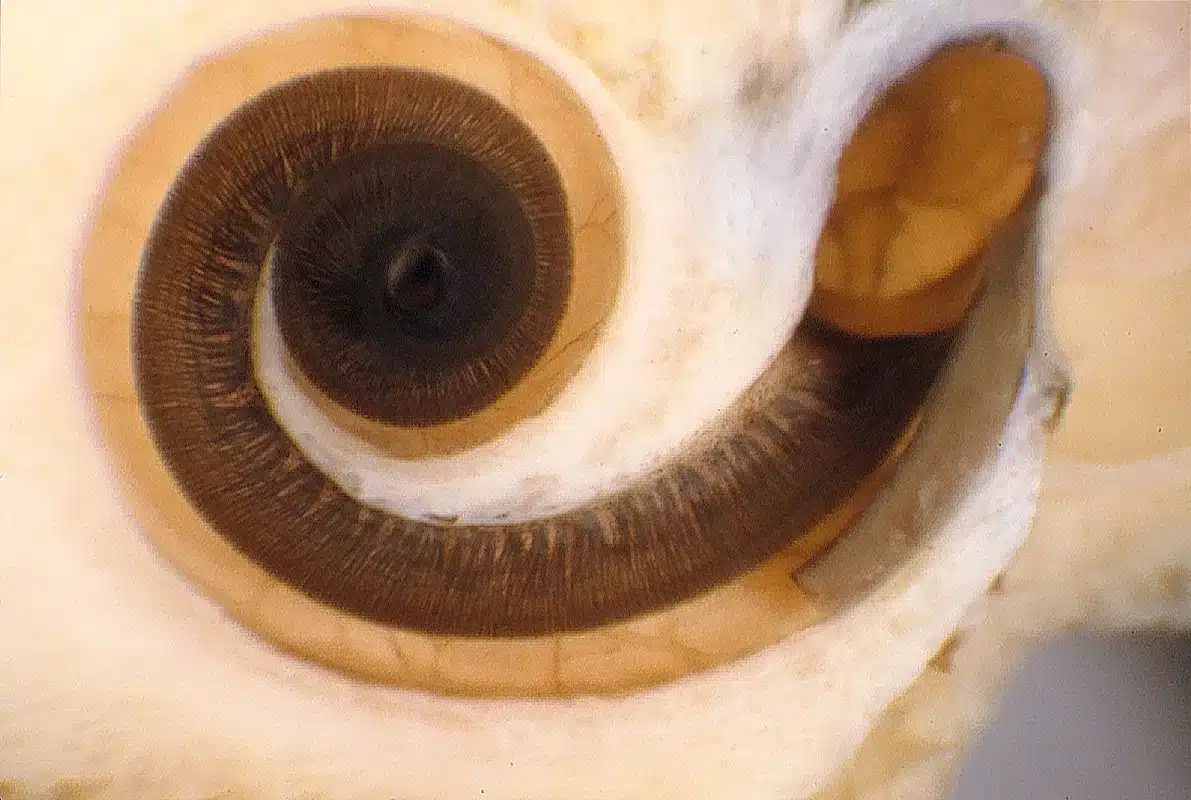
All about Taste:
Your tongue is covered with thousands of tiny taste buds. Taste buds contain special receptor cells that react to chemicals in foods. The information from the taste cells is sent to the brain through nerves, this tells you what flavours you are tasting.
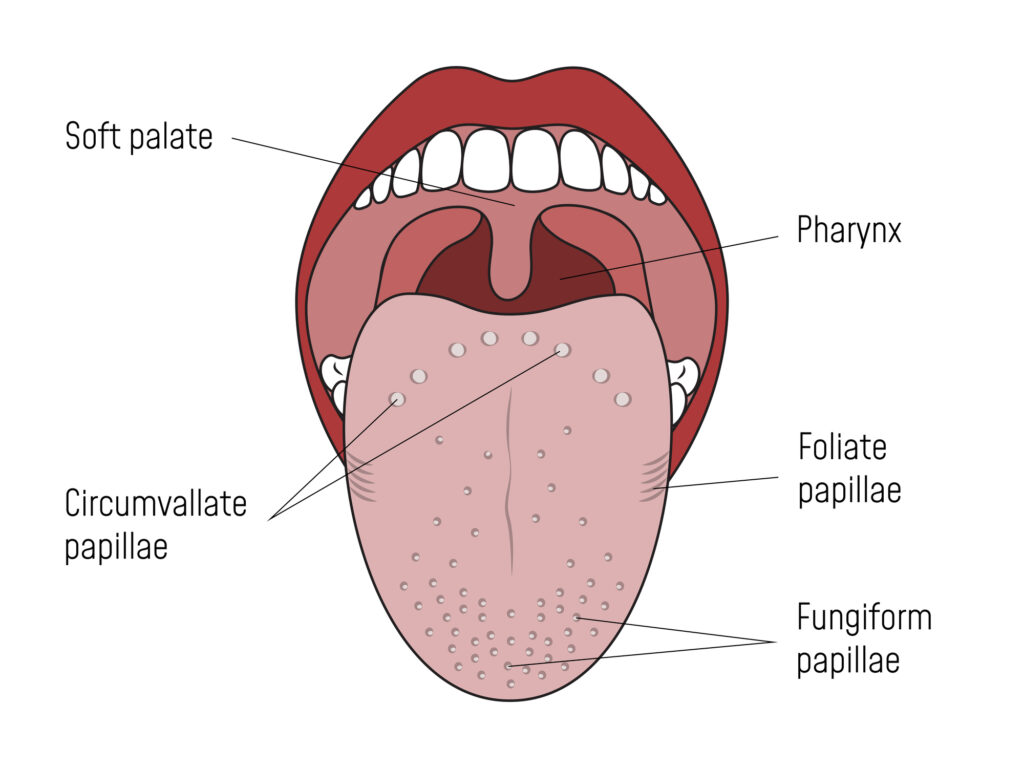
All about smell:
REMEMBER THE OLFACTORY BULB
There are chemical receptors in our nostrils. They detect chemicals in the air and then send messages to the brain which interprets the message and tells us what we are smelling.
Smell receptors above nasal cavity help stimulate ofalctoray bulb which then send messages to the brain which then tells us what we are smelling.
Smell is closely linked to taste

All about touch:
The bottom layer of the skin is called the dermis, it contains many nerve endings that can detect heat, cold, pressure and pain. Information is collected form these receptors and sent to the brain for processing.

What is the nervous system?
The body system that acts to control and coordinate the human body. It communicates messages throughout the body to move, to think and much more.
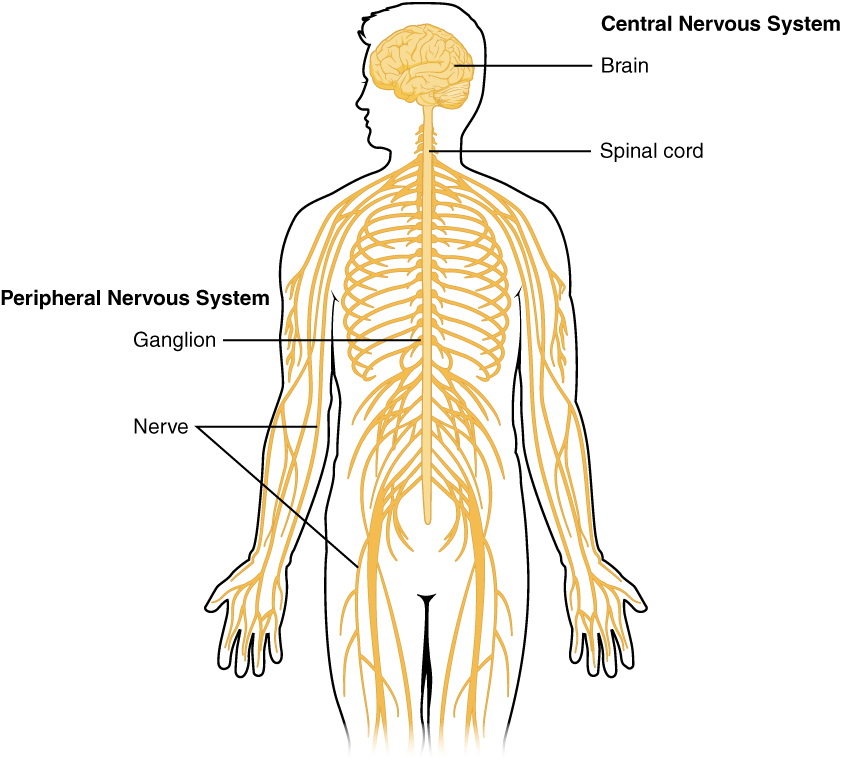
What are Neurons?
They are cells in our body that enable us to pass messages quickly to the brain and make a response to a stimuli. It is also the basic unit of the nervous system.
Draw the label the parts of a Neuron:
Dendrites: Receive signals from other neurons.
Cell Body (Soma): Contains the nucleus and processes incoming signals.
Axon Hillock: The region where the axon connects to the soma; it’s the site where action potentials are initiated.
Axon: Transmits electrical impulses away from the cell body.
Myelin Sheath: Insulates the axon to speed up signal transmission. They protect the message from getting lost and they are made out of Schwann Cells.
Nodes of Ranvier: Gaps in the myelin sheath that facilitate faster signal transmission. Like a rock skipping on a river this process is called, saltatory conduction.
Axon Terminals: Release neurotransmitters to communicate with other neurons or target cells.
Synaptic Vesicles: Tiny sacs in the axon terminals that store neurotransmitters, ready for release into the synapse during signaling.
Synapse: The gap between neurons where neurotransmitters cross to transmit signals.
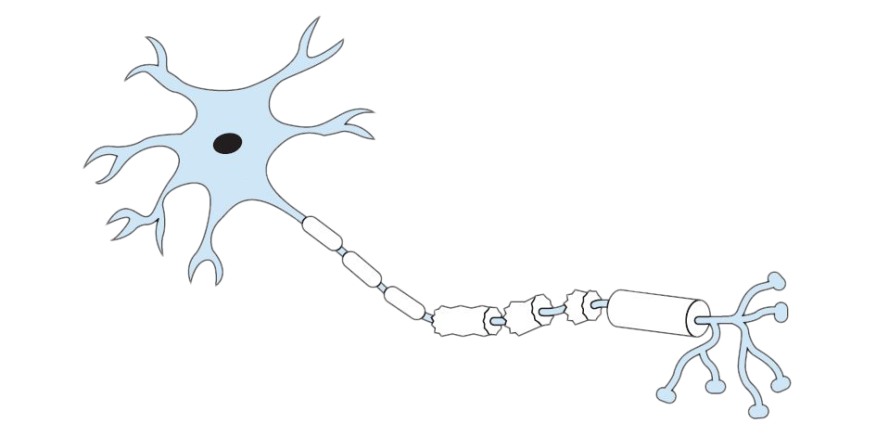
How a Message Fires Between Neurons
How a Message Fires Between Neurons
Signal Received by Dendrites: The dendrites of the first neuron receive a signal (chemical or electrical) from another neuron.
Processed by Soma: The signal is processed in the cell body (soma), and if strong enough, it triggers an action potential at the axon hillock.
Travels Down the Axon: The action potential travels as an electrical impulse along the axon, boosted by the myelin sheath and jumping at the Nodes of Ranvier (saltatory conduction).
Reaches Axon Terminal: When the signal reaches the axon terminal, it triggers calcium ions to enter the terminal through voltage-gated calcium channels.
Neurotransmitter Release: Synaptic vesicles release neurotransmitters into the synapse (the gap between neurons).
Crossing the Synapse: Neurotransmitters travel across the synapse and bind to specific receptors on the dendrites of the next neuron.
Signal Continues: The binding triggers an electrical signal in the second neuron, starting the process again
Neurotransmitters:
Chemical messengers that your body can’t function without. Their job is to carry chemical signals from one Neuron to the next target cell. The next target cell can either be a nerve cell, a muscle cell or a gland cell.
Synaptic Transmission Process:
"The neurotransmitter diffuses across the synaptic cleft and binds to receptors on the postsynaptic membrane. Depending on the specific neurotransmitter and receptor involved, this binding can generate either an excitatory postsynaptic potential (EPSP), which depolarizes the neuron and increases the likelihood of an action potential, or an inhibitory postsynaptic potential (IPSP), which hyperpolarizes the neuron and decreases the likelihood of firing."
Three types of Neurons:
Sensory Neurons:
They are sensitive to various different stimuli, collecting information from either the body’s internal environment or the outside world. They send information they have collected to the CNS for processing.
Motor Neurons:
They carry messages from the CNS to muscles cells throughout the body, which then carry out the response.
Interneurons:
Link sensory Neurons and motor Neurons, as well as other interneurons. They are the most common Neuron in your body and their only role is to make connections with other Neurons in your body.

Stimulus response model of homeostatic control:
*Define each part
Stimulus —> Receptor —> Control centre —→ effector —→ response.
Stimulus
Definition: A change in the environment (internal or external) that is detected by a receptor.
Example: Touching a hot stove. The heat is the stimulus.
Receptor
Definition: A structure that detects the stimulus and converts it into an electrical signal (nerve impulse).
Example: Thermoreceptors in the skin detect heat.
Control Centre
Definition: The part of the body (often the brain or spinal cord) that processes the information from the receptor and determines the response.
Example: The brain processes the message that the stove is too hot.
Effector
Definition: A muscle or gland that carries out the response based on the control center's decision.
Example: The muscles in your arm contract to pull your hand away.
Response
Definition: The action taken by the effector to counteract the stimulus and restore balance or protect the body.
Example: Moving your hand away from the stove.
Reflexes
Sudden movements the require special pathways that allow a response to occur before the brain has time to think.
-The sensory Neuron carries the message from the receptor to the spinal cord
-The interneuron then sends two messages at the same time, one to your brain and the other to the effect via the motor Neurons.
This means the muscle moves at the same time the brain gets the message.
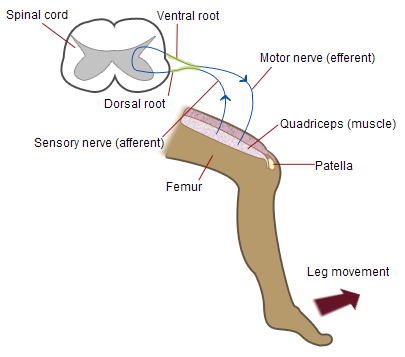
CNS:
PNS:
Central nervous system, the brain and spinal cord.
Peripheral nervous system, all the other nerves
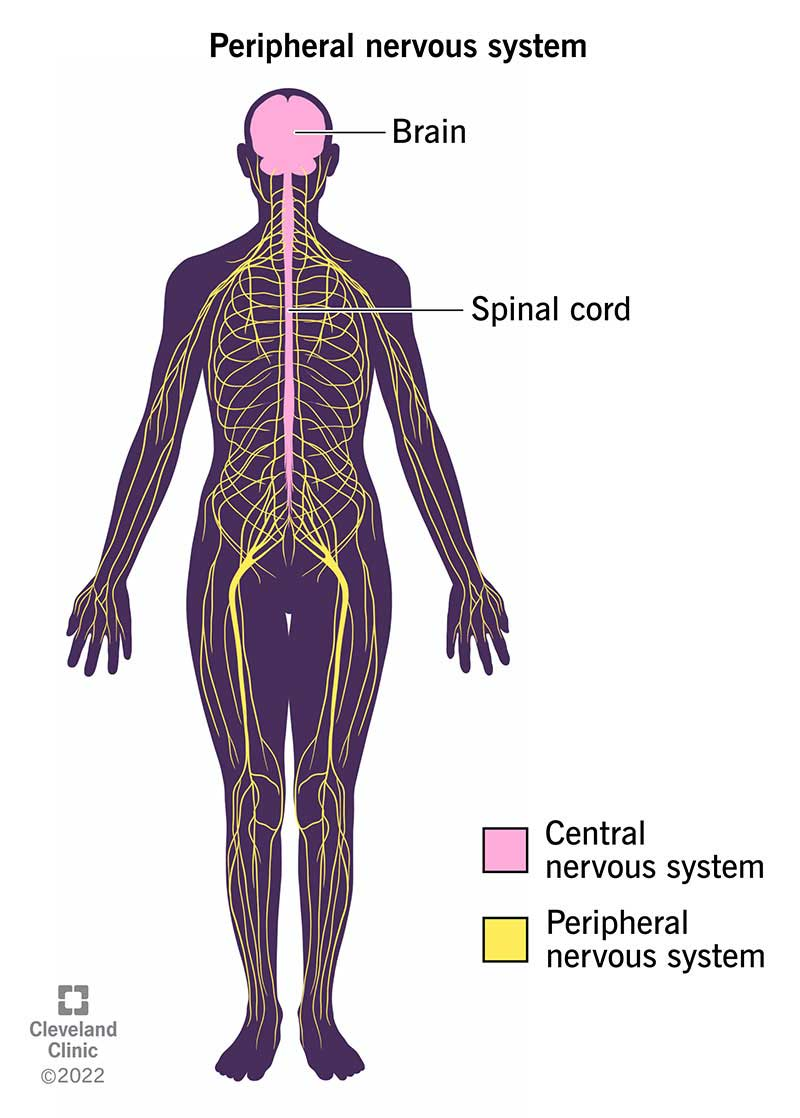
PARTS OF THE BRAIN: (Part 1)
Frontal Lobe
Parietal Lobe
Temporal Lobe
Occipital Lobe
-emotions, reasoning, and problem solving
-SENSE: taste, pain, pressure, temperature and touch
-sounds and smell
-various aspects of vision
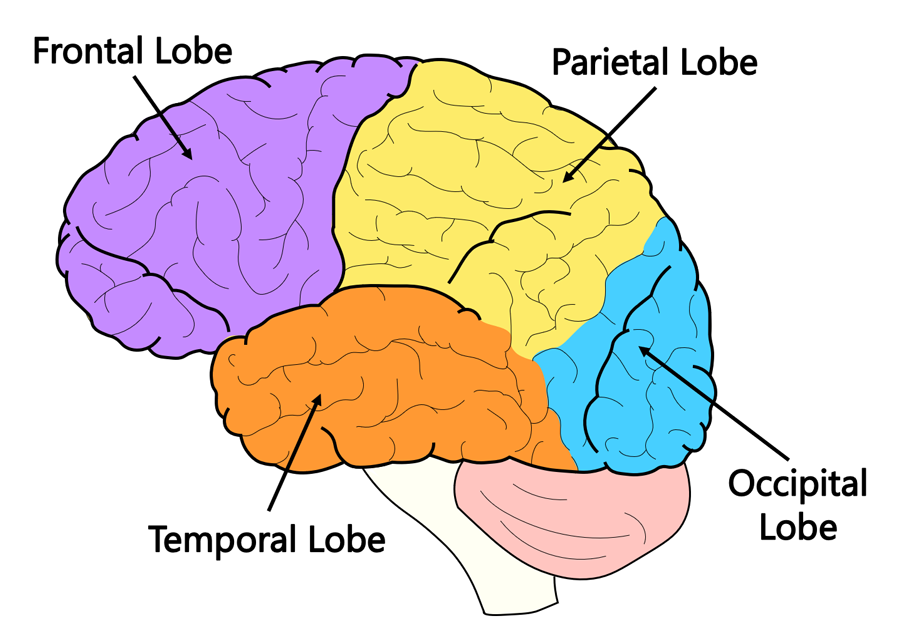
PARTS of the BRAIN: (Part 2)
Cerebrum
Cerebellum
Hypothalamus
Brainstem
-sends the signals to the muscles
-helps calculate and control your movements
-a structure deep in your brain acts as your bodies smart control coordinating centre. Its main function is to keep your body in a stable state called homeostasis It is the link between the NS and the ES.
-helps regulate some body functions, including your breathing and heart rate.
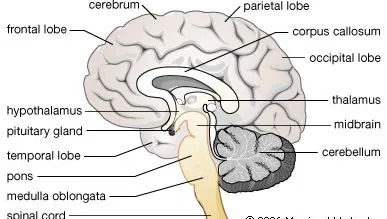
PNS subparts:
Somatic Nervous System:
-controls voluntary skeletal muscles movements, such as waving or reaching out to take an object
Autonomic Nervous System:
-Controls involuntary actions.
-heartbeat
-digestion
-salivation
-respiration
-perspiration
(⏫ Homeostasis)
Autonomic NS subtypes
Sympathetic:
Speeds up the heart rate
Parasympathetic:
Slows it down
(BOTH WORK TOGETHER TO MAINTAIN A BALANCE IN THE BODY)
THINGS CAN GO WRONG:
Spinal Damage:
Slipped disc:
Multiple Sclerosis:
ALS:
Alzheimers Disease:
Spinal Damage
Damage to the spinal cord can disrupt nerve signals between the brain and body, leading to paralysis, numbness, or loss of function below the injury.
Slipped Disc
Between the 26 vertebrae in your spine are soft, gel-like discs that cushion and support movement. A slipped disc occurs when one of these discs bulges or ruptures, pressing on nearby nerves, causing pain, weakness, or numbness.
Multiple Sclerosis (MS)
An autoimmune disease where the immune system attacks the myelin sheath around nerves, disrupting communication between the brain and body, leading to weakness, balance issues, and fatigue.
ALS (Amyotrophic Lateral Sclerosis)
A progressive condition where motor neurons in the brain and spinal cord die, leading to muscle weakness, paralysis, and eventually difficulty breathing.
Alzheimer’s Disease
A progressive brain disorder caused by abnormal protein deposits (plaques and tangles), leading to memory loss, confusion, and cognitive decline.
What is the endocrine system?
A collection of glands that release hormones. Which are chemicals in your body that send messages to coordinate it and maintain homeostasis.
The hormones can match to certain receptors like a lock and key, these cells are called target cells.
Homeostasis: (2 POINTS)
The process of maintaining constant internal environment.
-coordinated by the nervous system and the endocrine (hormone) system
-using a feedback loop - mostly negative (counteracts a stimulus)
Body cells work best when they have the correct:
Body temperature
ph
water levels
hormones
glucose regulation
FLIGHT OR FIGHT RESPONSE
(Epinephrine)
When you are in danger, adrenalin takes on another role. It floods into your system causing an increase in the strength and rate of your heartbeat. Raising your blood pressure and speeding up the conversion of glycogen into glucose which produces energy to the muscles, this way adrenaline prepares your body for the extra effort required should you defend yourself (fight) or run away (flight.)
Plant Hormones
Plants have no nervous system or muscle tissue but they are highly sensitive to environmental cues and stimuli and detect and respond to small changes.
Positive Phototropism: sensitive to the direction of light
Geotropism: sensitive to the pull of gravity
E.g Gibberellins, Cytokinis and Ethene

Negative Feedback
Occurs when the body responds in a way that removes the initial stimulus.
Examples:
To maintain homeostasis your body uses a mechanism a bit like a thermostat on a heater.
When temperature receptors on your skin and in the hypothalamus of your brain detect cooling down, (stimulus) then a message gets sent to a variety of effectors around your body. This may include muscles to make you shiver (to warm up) or blood vessel to redirect the warm blood flow to the important organs of the body, your heart, liver and brain.
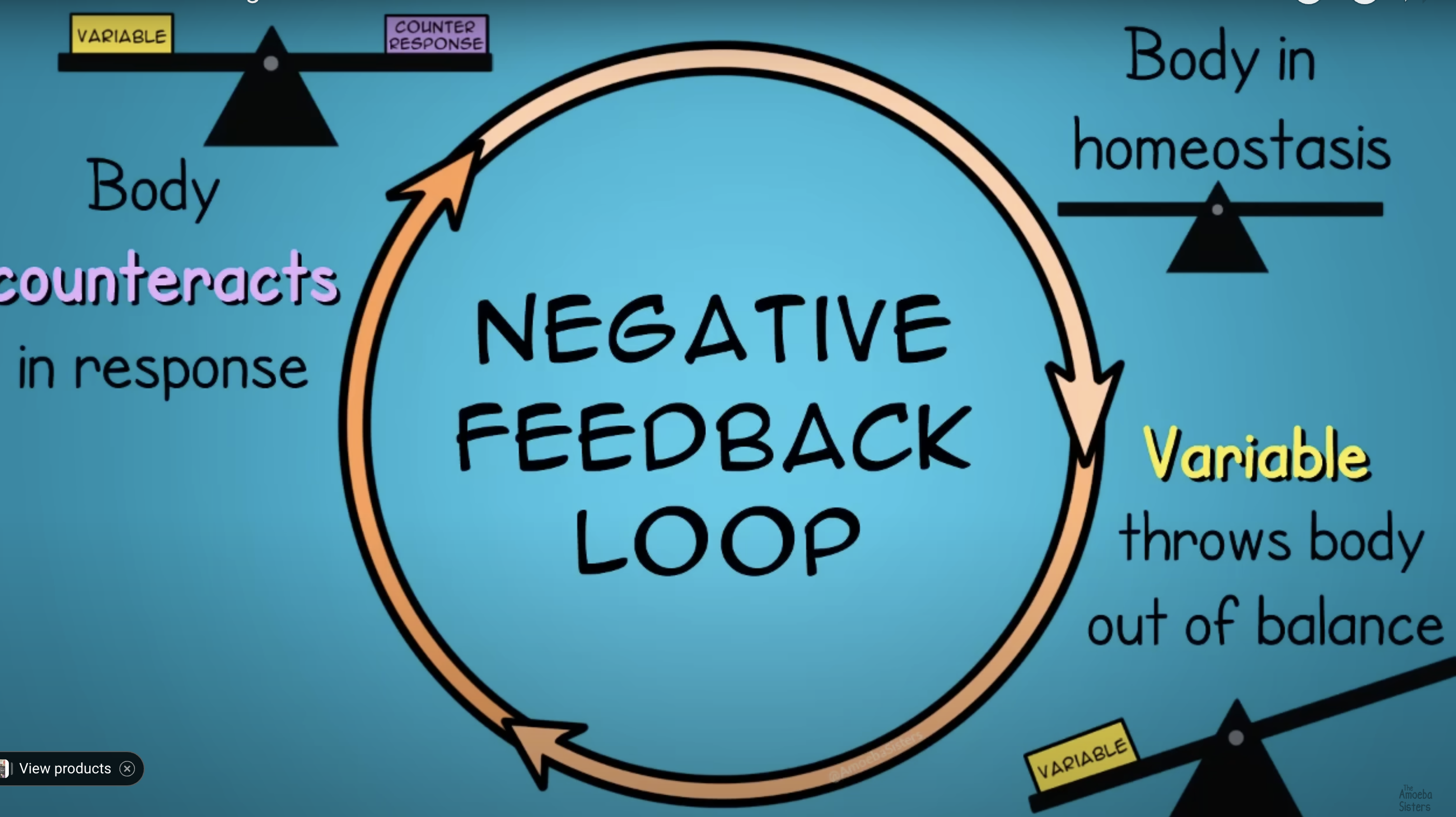
Blood Glucose Regulation
When the blood glucose in the body is too high (stimuli) the receptors in the pancreas will detect it and secretes the hormone insulin which will cause muscle and liver cells to increase uptake of glucose from the blood, This causes the blood glucose to decrease, removing the original stimuli.
If the blood glucose in the body is too low, there receptors in a pancreas will detect it and secrete the hormone glucagon which will cause muscle and liver cells to release their stored glucose into the blood thus raising the blood glucose level, making the blood glucose level balanced once more.
What is thermoregulation?
An organisms ability to maintain a steady body temperature in a variety of external conditions.
To gain:
They can gain heat from the sun or as a by-product of reactions and metabolism, such as cellular respirations or muscle contractions.
OR
Heat produced as a by-product of metabolic reactions i known as metabolic heat and is distributed by blood circulation.
To loose:
Evaporation of water vapour from the bodies surface
Radiation, convection and conduction.
Endothermic Mammals
Their temperature remains constant within their bodies.
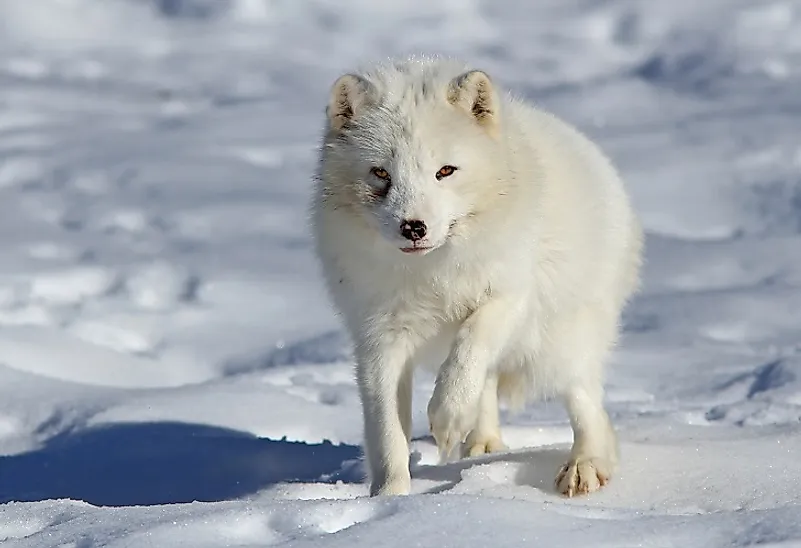
Ectothermic Cold Blooded Animals
Their body temperature fluctuates according to their environment.
Example:
A reptile can warm up to a good working temperature by basking in the sun and shade.

Characteristics of Thermoregulations in animals:
Notes:
Animals that live in hot areas: They have little fur and typically have external ears that are full of blood capillaries.
The external ear functions as a radiator which enables the animals to loose heat rapidly.
Elephants fan their ears to speed up heat loss by radiation and convection.
Animals living in cold regions tend to be larger animals.
Aquatic animals conserve heat by having a thick layer of fat (blubber)
Erythropoietin
Erythropoietin (EPO) is a hormone produced by the kidneys that stimulates the bone marrow to produce more red blood cells, increasing oxygen delivery to muscles.
Athletes train at high altitudes to naturally boost EPO levels, as low oxygen signals the body to produce more.
However, injecting synthetic EPO can dangerously thicken the blood, increasing the risk of heart attacks and strokes. The effects of EPO can last several weeks, providing an extended performance advantage.
Medical uses of Erythropoietin
When someone has kidney disease it will effect their ability to produce Erythropoietin causing a lack of red blood cells (anemia) they may feel tired and pale as their is not as much blood cells to carry oxygen to places in need. So, EPO is injected.
Pathogens:
Microorganisms that cause diseases.
All about Penicillin:
Discovery of Penicillin: Alexander Fleming discovered penicillin accidentally while growing bacteria.
Observation: He noticed mold on petri dishes left open, with no bacteria growing near it.
Investigation: The mold (Penicillium) released a chemical that killed bacteria.
Mechanism: Penicillin works by breaking down bacterial cell walls.
Safety for Humans: Human cells are unaffected because they lack cell walls.
Limitations: Penicillin is ineffective against viruses, which have a protein coat, not a cell wall, and thus cannot treat viral infections like the flu or common cold.
Immune System
The role of your immune system is to protect you against foreign invaders by physically stopping them from entering your body, identifying and attacking them if they manage to enter.
First line of Defence (Immune System)
Stop the pathogen from getting into your body. It consists of the skin and mucous membrane.

Second Line of Defence (Immune System)
1. General Defense (Non-Specific)
Blood Clotting: Stops more pathogens from entering through wounds.
Inflammation: Brings more blood cells to the infection site.
Fever: Raises body temperature to kill some pathogens.
2. Targeted Defense (White Blood Cells)
White Blood Cells: Attack and destroy pathogens.
Inflammation: Helps more white blood cells reach the area.
Swelling: Fluids increase as a response to infection.
Difference between Bacteria and Virus
Viruses contain a protective coating that allows them to more easily slip through the first line of defence.
Phagocytosis
A type of white blood cell.
Deals with non specific immune response
They surround and absorb pathogens, destroying them in a process called phagocytosis.
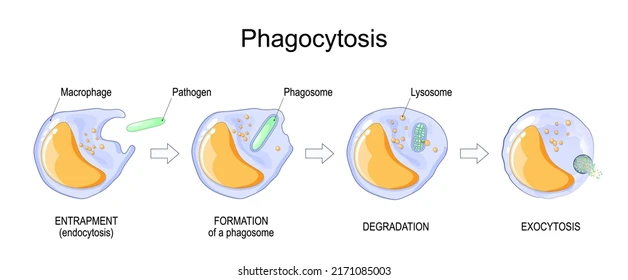
Third line of defence (Immune system)
1. B Cells
Antibodies: Produced to match a pathogen’s antigen, neutralizing it by preventing infection.
2. T Cells
Attack: Identify and destroy infected cells, killing the pathogen directly.
3. Memory Cells
Immunity: B and T cells create memory cells that remember the pathogen, enabling a faster, more effective response if it returns.
4. Timing
Response Time: It can take up to a week to recognize and eliminate the pathogen.
Antibodies can be also…
Passed to babies through breast milk.
Vaccination / Innoculation
The dead pathogen
A living but weakened form of the pathogen
parts of the broken up pathogen
Through vaccination a person makes antibodies, which usually leads to immunity.
Allergies
Allergies occur when the immune system mistakenly identifies a harmless substance like pollen as a pathogen. When pollen enters the body, the second and third lines of defense attack it, causing inflammation. This leads to increased blood flow, fluid leakage from blood vessels, redness, and swelling. The body's response also results in symptoms such as a runny nose and watery eyes as it tries to flush out the pollen.
What is anaphylaxis?
: Anaphylaxis is a severe, life-threatening allergic reaction that occurs quickly after exposure to an allergen, such as certain foods, insect stings, or medications. It happens when the immune system overreacts to a harmless substance, causing extreme symptoms like difficulty breathing, throat swelling, low blood pressure, and potential loss of consciousness. Immediate treatment with epinephrine (adrenaline) is crucial to reverse the reaction and prevent serious consequences.
Autoimmune Diseases
A group of disease that result from your body’s immune system identifying healthy parts of your body as a pathogen. For example Rheumatoid Arthritis is an autoimmune disease that produces B and T cells that attack the joints of the body.
Type 1 Diabetes
Autoimmune reaction against the cells in the pancreas that produce insulin. As a result of B cells antibodies and T cells, these cells are destroyed. This means the person is unable to control their own blood glucose levels and must test their glucose levels regularly and inject artificial insulin when it is needed.
HIV causes AIDS
Human Immunodeficiency Virus (HIV) is a virus that infects a specific type of T cell in the immune system, weakening the entire immune system. As a result, a person with HIV is more vulnerable to infections that a healthy immune system could easily fight off. For example, viral eye infections, simple fungal infections, and diarrhea can cause serious illness. When these symptoms occur together, they are referred to as Acquired Immunodeficiency Syndrome (AIDS).
Sensory
Activated by sensory input from the environment
State the role of the endocrine system in maintaining homeostasis:
The endocrine system controls growth and development during childhood, regulation of bodily functions in adulthood, and the reproductive process.
Outline the role of hormones in the endocrine system including how hormones travel around the body.
Endocrine glands release hormones into the bloodstream. This lets the hormones travel to cells in other parts of the body. The endocrine hormones help control mood, growth and development, the way our organs work, metabolism and reproduction. The endocrine system regulates how much of each organ is released.
Infectious Vs Non-infectious Disease
An infectious disease is caused by the spread of pathogens and is a contagious disease. A non-infections disease is not caused by the spread of pathogens and is non-contagious.
List of Pathogens
Viruses - Tiny infectious agents that need a host cell to replicate.
Bacteria - Single-celled microorganisms that can be harmful or beneficial.
Fungi - Includes molds, yeasts, and mushrooms; some can cause infections.
Parasites - Organisms like worms or protozoans that live in or on a host.
Prions - Abnormal proteins that cause brain diseases like BSE.
Protozoans - Single-celled organisms, often transmitted by water or insects (e.g., malaria).
Do viruses have cell walls, and what genetic material do they contain?
Viruses do not have cell walls; they have a protein coat and sometimes a lipid envelope. They contain either RNA or DNA, but never both.
What type of cell wall and genetic material do bacteria have?
Bacteria have cell walls made of peptidoglycan and contain only DNA for their genetic material.
What are fungi's cell walls made of, and what genetic material do they have?
Fungi have cell walls made of chitin and contain only DNA as their genetic material.
Lymphocytes
Lymphocytes are a type of white blood cell (leukocyte) that plays a critical role in the immune system, particularly in fighting infections and providing immunity.
Types of Lymphocytes
B cells: Produce antibodies that specifically bind to antigens on pathogens, marking them for destruction or neutralizing them.
T cells: Directly attack infected or abnormal cells. They recognize these cells because the antibody-antigen complexes signal that the cell is compromised.
Memory cells: Some B cells remain after an infection to provide long-term immunity.
Characteristics of Bacteria
Cell wall: Bacteria have a cell wall that provides structure and protection.
Lack of nucleus: Bacteria do not have a nucleus; their genetic material floats freely in the cytoplasm.
Asexual reproduction: Bacteria reproduce asexually through binary fission, where one cell splits into two identical cells.
Most Bacteria…
That live on or in the human body are harmless and have a beneficial function in the body.
Why do some bacteria make us sick?
Some bacteria release toxins or invade our cells, damaging tissues and disrupting normal body functions, which causes illness. Not all bacteria are harmful, but the harmful ones can overwhelm our immune system and cause disease.
Characteristics of Viruses
protein coating called a capsid that contains and encloses genetic information
they reproduce in host cells
What is an antigen?
An antigen is any substance that triggers an immune response in the body. It acts like a "red flag," signaling that something foreign (like a pathogen) has entered the body. The immune system recognizes these antigens and responds by producing antibodies to target and neutralize the pathogen.
Histamines
Histamine is a chemical released by cells during an immune response. It causes blood vessels to expand (dilate), increasing blood flow to the infected area. This leads to redness, warmth, and swelling, helping immune cells reach the site of infection. Histamine also makes blood vessel walls more permeable, allowing white blood cells to pass through and fight pathogens. This process is part of the body's inflammatory response.
Macrophages
Macrophages are large white blood cells that are part of the immune system. They play a key role in the second line of defense by engulfing and digesting pathogens, dead cells, and other debris. This process is called phagocytosis.
Uses of Pathogens:
Fungi
Bacteria
Viruses
Used for pest control and food preparations
Neutralising toxins, degrading food and making nutrients available
Creating vaccines and targeting specific cells.
Four signs of inflammation
Redness happens because blood vessels expand, increasing blood flow to the area. This helps deliver immune cells and nutrients for healing.
Heat is caused by the warm blood flowing to the area, which helps fight pathogens and speed up healing.
Swelling occurs when fluid leaks from blood vessels into surrounding tissue, carrying immune cells to fight infection and repair damage.
Tenderness is due to swelling and irritated nerves, making the area painful to touch and protecting the injured tissue.
Loss of function happens when the injury affects movement, helping to prevent further harm and allow healing.
Receptors VS Nerve Cells
Receptors detect specific stimuli and convert them into electrical signals, while nerve cells (neurons) transmit those electrical signals throughout the body.
Receptors are located at the sensory end of the nervous system, such as in the skin or organs, while nerve cells are the long structures that carry the signals from the receptors to the brain or from the brain to the rest of the body.
Receptors respond to stimuli like light, sound, or chemicals, whereas nerve cells process and transmit these signals over long distances.